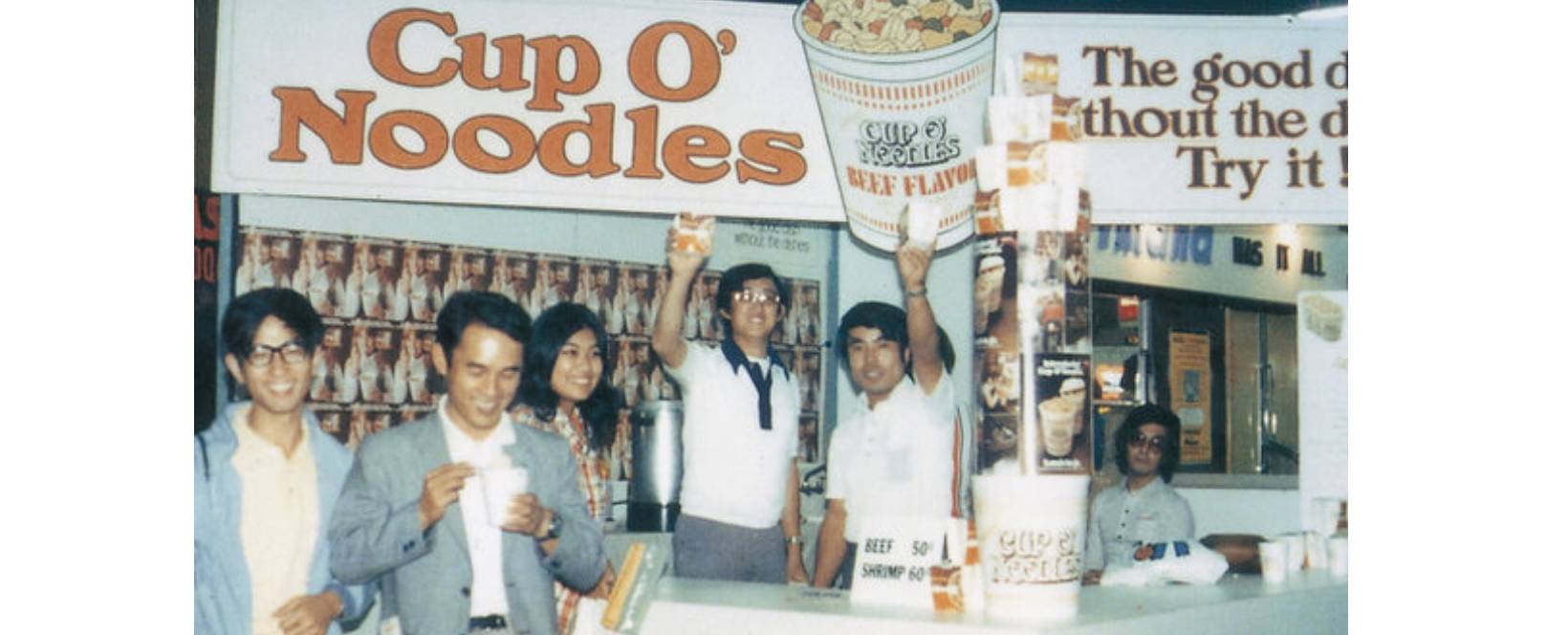No products in the cart.
Nissin Cup Noodles: The History of Japan’s #1 Most Iconic Snack
A Nissin Cup Noodles container at a convenience store may evoke images of dorm rooms and budget-friendly meals. However, there was a time when slurping noodles from these iconic cups symbolized cosmopolitanism and opportunity—a fusion of Japanese innovation with American convenience.
A Flash of Inspiration: Momofuku Ando’s Nissin Cup Noodles Vision
The story of Cup Noodles traces back to Momofuku Ando, the mastermind behind instant ramen, who founded Nissin Foods in 1948. Born in Japan-occupied Taiwan, Ando moved to Osaka in 1933, where he witnessed the scarcity of food during wartime. Inspired to create accessible noodles for home consumption, he embarked on a journey of experimentation.
After numerous trials, Ando’s breakthrough came in 1958 when he observed the dehydrating effects of oil while his wife fried tempura. This revelation led to the invention of instant ramen—fried and dried noodles that could be rehydrated with boiling water, combined with seasoning powder, and topped with dehydrated ingredients.
Transpacific Inspiration: Adapting to American Tastes
In the mid-1960s, Ando recognized the declining sales of instant ramen in Japan and turned his attention to the United States. During a visit to promote his product, Ando observed Americans breaking dried noodles into cups and pouring boiling water—a revelation that sparked the idea for Nissin Cup Noodles. During his visit to the United States, Ando witnessed Americans’ fast-paced lifestyles and their inclination towards convenience foods. This observation reinforced his belief in the potential success of instant noodles tailored to the American market. Inspired by this encounter, Ando returned to Japan determined to revolutionize the instant noodle industry with the innovative concept of Cup Noodles.
On-the-Go Dining: Revolutionizing Convenience
The development of Nissin Cup Noodles required innovative packaging—a plastic foam cup that expanded to accommodate the noodles. The inclusion of a pull-back lid and a small plastic fork catered to the convenience of eating on the move, a departure from traditional Japanese dining norms. The revolutionary packaging of Nissin Cup Noodles not only facilitated easy consumption but also contributed to its widespread popularity among consumers seeking quick and convenient meal options. By incorporating a pull-back lid and providing a small plastic fork, Nissin addressed the practical challenges associated with consuming noodles on the go, further enhancing the product’s appeal. This departure from traditional dining norms in Japan reflected a broader cultural shift towards embracing convenience and adaptability in modern lifestyles.
Cultural Fusion: Marketing and Promotion
Nissin’s strategic marketing initiatives played a pivotal role in solidifying Nissin Cup Noodles’ position as a market leader, utilizing tactics such as nostalgic branding, the introduction of limited-edition flavors, and high-profile collaborations with celebrities. This multifaceted approach not only enhanced brand visibility but also fostered a strong emotional connection with consumers, contributing to sustained sales growth over the years. In Japan, Nissin Cup Noodles became synonymous with the modern pursuit of convenience and comfort, earning a ubiquitous presence in convenience stores and vending machines nationwide.
Global Expansion: From Japan to the World
The introduction o Nissomf Cup Noodles to the United States in 1973 heralded the start of its global expansion, showcasing its adaptability to diverse markets. Rebranded as “Cup O’Noodles” initially and later simplified to “Cup Noodles,” the product underwent localization efforts tailored to American preferences, featuring shorter noodles and a streamlined flavor selection. This strategic approach ensured greater resonance with American consumers while retaining the core essence of the beloved instant ramen.
A Symbol of Success: Legacy and Recognition
Today, Cup Noodles embodies a blend of trendiness and nostalgia in Japan, with themed museums and celebrity endorsements. Its global presence spans over 80 countries and territories, each offering localized variants. However, in America, Cup Noodles thrives by assimilating into mainstream culture, concealing its Japanese origins while embracing its role as a ubiquitous comfort food.
Conclusion: A Culinary Journey Across Borders
The evolution of Cup Noodles encapsulates a narrative of cultural exchange and culinary innovation, from its humble origins in Japan to its status as a global phenomenon. As consumers continue to embrace the convenience and versatility of instant ramen, Cup Noodles remains a timeless icon, transcending borders and uniting palates worldwide.










